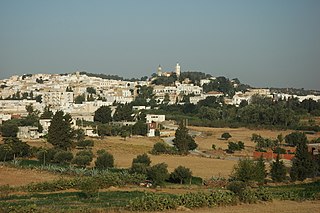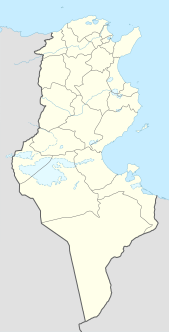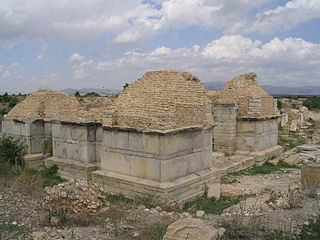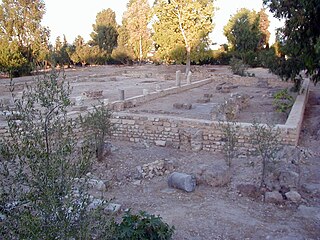
Gafsa, originally called Capsa in Latin, is the capital of Gafsa Governorate of Tunisia. It lends its Latin name to the Mesolithic Capsian culture. With a population of 105,264, Gafsa is the 9th-largest Tunisian city.

Zaghwan is a town in the northern half of Tunisia.

Kelibia (Kélibia), often referred to as Klibia or Gallipia by European writers, is a coastal town on the Cap Bon peninsula, Nabeul Governorate in the far north-eastern part of Tunisia. Its sand beaches are considered some of the finest in the Mediterranean.
Usilla or Usula was a town in the Roman province of Byzacena, now Inchilla in Tunisia.

Thelepte was a city in the Roman province of Byzacena, now in western Tunisia. It is located 5 km from the modern town of Fériana, near the border with Algeria, at around 34°58′33″N8°35′38″E.

Segermes is an ancient town in Tunisia. Under the Roman Empire, the city belonged to the province of Byzacena. The town is identified with ruins at Henchir Harat, Zaghouan( 36° 20′ 43″ N, 10° 18′ 03″ E).

Djinet, the classical Cissi, is a port town and commune in the Bordj Menaïel District of Boumerdès Province, Algeria, east of the mouth of the Isser River and around Cape Djinet. As of 2008, the population of the municipality is 21,966.

Téboursouk is a town and commune in the Béja Governorate, Tunisia. It is located at 36° 27′ 26″N, 009° 14′ 54″E.

Bir El Hafey is a town and commune located at 34°55′48″N 9°12′00″E in the Sidi Bouzid Governorate, in Tunisia. As of 2004 it had a population of 36,405.

Pupput, also spelled "Putput", "Pudput", "Pulpud" and "Pulpite" in Latin, sometimes located in Souk el-Obiod ou Souk el-Abiod, is a Colonia in the Roman province of Africa which has been equated with an archaeological site in modern Tunisia. It is situated on the coast near the town of Hammamet, between the two wadis of Temad to the north and Moussa to the south. Much of the Pupput is buried under modern holiday developments which have been built over the major part of the site.

The Archdiocese of Carthage, also known as the Church of Carthage, was a Latin Catholic diocese established in Carthage, Roman Empire, in the 2nd century. Agrippin was the first named bishop, around 230 A.D. The importance of the city of Carthage had previously been restored by Julius Caesar and Augustus. When Christianity became firmly established around the Roman province of Africa Proconsulare, Carthage became its natural ecclesiastical seat. Carthage subsequently exercised informal primacy as an archdiocese, being the most important center of Christianity in the whole of Roman Africa, corresponding to most of today's Mediterranean coast and inland of Northern Africa. As such, it enjoyed honorary title of patriarch as well as primate of Africa: Pope Leo I confirmed the primacy of the bishop of Carthage in 446: "Indeed, after the Roman Bishop, the leading Bishop and metropolitan for all Africa is the Bishop of Carthage."
Avioccala was a Roman and Byzantine era town in the Roman province of Africa Proconsularis in northern Tunisia. The town lasted from 30BC to about 640AD, and has been tentatively identified with the stone ruins at Sidi-Amara, Tunisia.

Aeliae or Æliæ was a Roman-era city in the province of Byzacena.

Auzegera was a Roman-Berber town in the province of Africa Proconsularis and in late antiquity Byzacena. It was a Catholic Church diocese.

Cubda was an ancient city in Tunisia. It is a titular bishopric of the Roman Catholic Church.

Tagarata, was a Roman era civitas of the Roman province of Africa Proconsularis. The ancient town has been tentatively identified with ruins either at Tell El-Caid, one of three tell at Aïn-Tlit or Henchir Kahloulta in the region of Carthage, Tunisia. The ancient town is known to history as the home of the Donatist Bishop Donato, who intervened at the Council of Carthage (411), it seems that time the town had no Catholic bishop. The bishopric exists today only as a titular see of the Roman Catholic Church and the current bishop is José Ramiro Pellecer Samayoa, of Guatemala.

The Diocese of Sinnuara is a sede soppressa and titular see of the Roman Catholic Church. The bishopric is suffragan to the Archdiocese of Carthage.

Feradi Minor was an ancient town in the Roman province of Africa proconsularis in the Sahel region of Tunisia. During late antiquity it was in the province of Byzacena.

The Diocese of Dices, is a titular see of the Roman Catholic Church. The location of the seat of the diocese is unknown for certain, but is perhaps identifiable with Henchir-Sidi-Salah, Tunisia. Henchir Sidi Salah was an ancient diocese in the Roman-Berber province of Byzacena.
The Diocese of Vittoriana is a suppressed and titular see of the Roman Catholic Church.

















